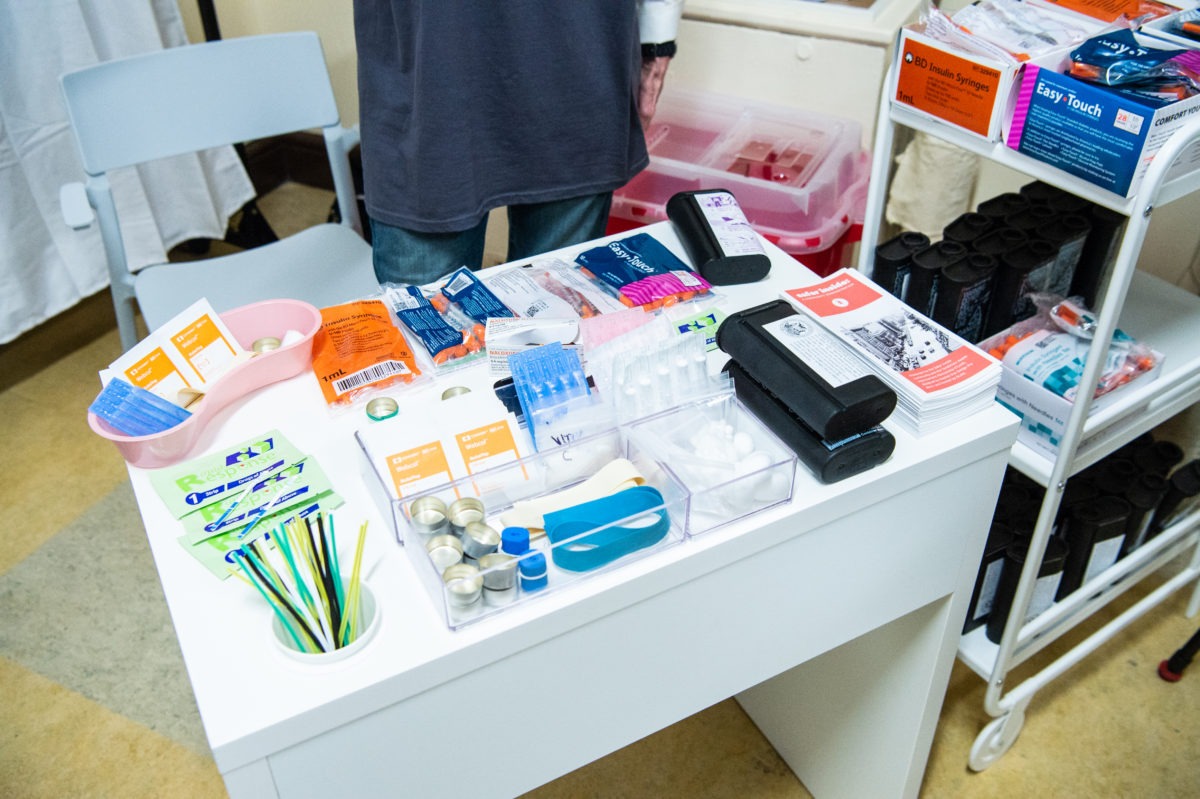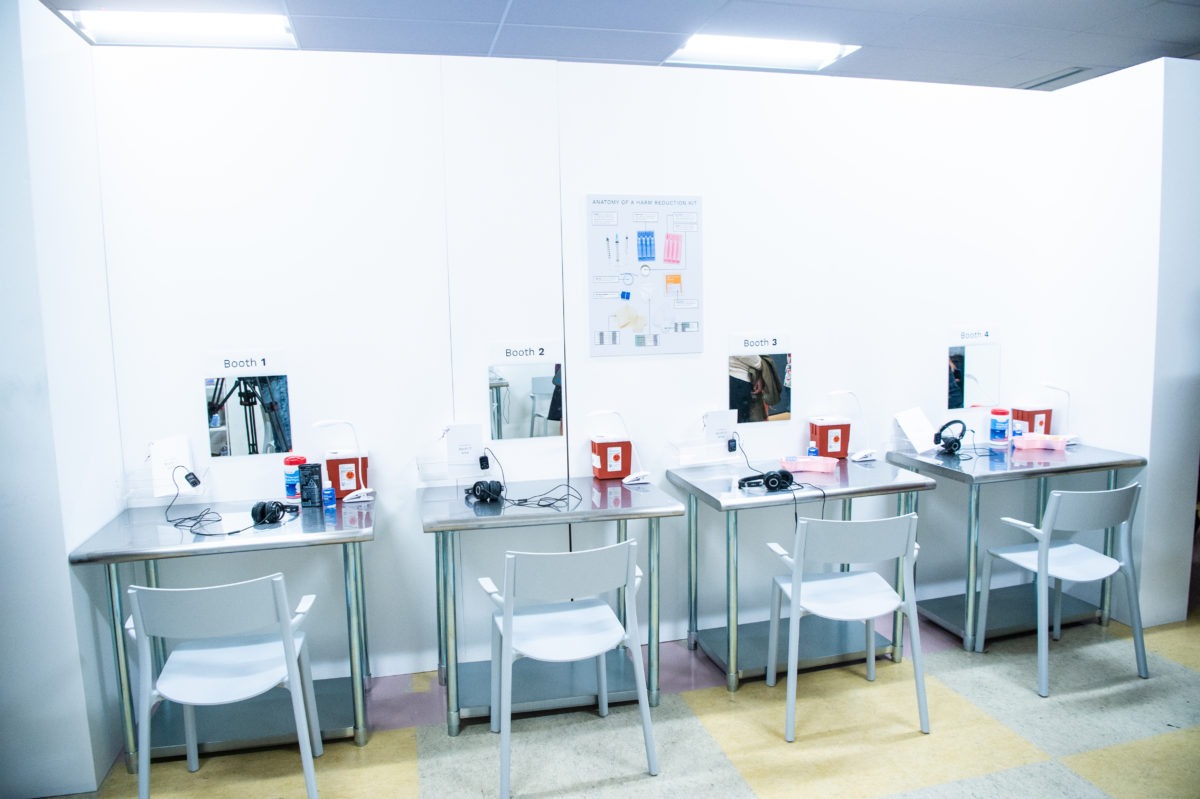Safe Injection Sites Are On the Way. But Will Prosecutions Follow?
As the federal government vows to pursue ‘swift and aggressive action’ against the sites, experts weigh in on what’s likely to happen next.

Christina Garcés and her team of volunteers spend every Sunday in Philadelphia’s Kensington neighborhood, the heart of the city’s opioid epidemic. Part of a local harm-reduction group called SOL Collective, they frequently run out of Narcan, the opioid overdose reversal drug, because the people they work with so often request it. “The reason why we’re out here is because we’re trying desperately to fill a gap in healthcare,” Garcés explained.
City leaders have proposed a safe injection site to lessen that gap. The idea behind it is simple, if controversial: Having a place where people struggling with addiction can shoot up under the supervision of medical professionals has been shown to prevent lethal overdoses.
Yet opponents, including the Department of Justice, view the concept as government-sanctioned illicit drug use—a stance Deputy Attorney General Rod Rosenstein made clear in an opinion article in the New York Times. “Advocates euphemistically call them ‘safe injection sites,’ but they are very dangerous and would only make the opioid crisis worse,” he wrote, promising to “meet the opening of any injection site with swift and aggressive action.”
That could pose a problem in a number of jurisdictions, both cities and states, that have reportedly started the process of establishing official safe injection sites. Still, in recent weeks, state and local lawmakers in California and Philadelphia have stepped up their public support for creating them in defiance of the federal government. A bill sitting on California Governor Jerry Brown’s desk would greenlight San Francisco to establish what could be the country’s first safe injection site pilot. On Sept. 4, local officials pressured him to do so at a press conference where San Francisco Mayor London Breed vowed to open a supervised injection site soon, whether or not the state bill is signed and despite federal opposition.
And on the other coast, a spokesperson for Philadelphia’s Department of Public Health, James Garrow, has endorsed plans to open a site. “The evidence speaks for itself—overdose prevention sites can save lives and reduce neighborhood disorder,” he said in a statement. “The federal government should focus its enforcement on the pill mills and illegal drug traffickers who supply the poison that is killing our residents, not on preventing public health officials from acting to keep Philadelphians from dying.”
However, in both San Francisco and Philadelphia, the proposed sites would be run by nonprofits rather than the cities themselves. And, as of yet, no official has proposed a plan to protect any organization willing to host a safe injection site or their workers from federal prosecution. In an interview with NPR, Rosenstein reiterated that “[P]eople who engage in that activity remain vulnerable to civil and criminal enforcement.” He suggested that advocates who want to protect people who use or oversee the use of an illicit opioid should “persuade the U.S. Congress to legalize it”—an unlikely outcome under Republican rule.

When asked about the threats inherent in these sites, officials in both Philadelphia and San Francisco seemed to sidestep the question. “[A]ny such center would have proper security precautions in place,” Garrow said in a statement, declining to offer specifics. Mayor Breed also addressed the issue with a vague response. “There are some challenges with federal law,” she said. “We need to make sure that the people who are going to be working at these sites are protected.”
The Appeal contacted some likely nonprofit partners to discuss the legal risk, but none were prepared to say whether they would host a safe injection site if propositioned or to speculate on the consequences.
How controversy grew
While safe injection sites were controversial before President Trump was elected, the issue seemed to fly under the radar of the federal government then, said Corey Davis, an attorney with the National Health Law Program who has been researching and advocating safe injection sites for a decade.
“Up until AG [Jeff] Sessions, I thought it was very clear: You should try to get as much authorization as you can at the state and local level. Make sure your local police forces are on board; that was what you really had to worry about,” Davis said. This is not to say that the sites were popular in Washington, he explained, but that the battle would most likely be a local one. “I thought it would be really silly to worry that the DEA would take action,” he said.
But it wasn’t silly after all. And Rosenstein has the law behind him: Heroin is a Schedule 1 drug, which means the Drug Enforcement Administration classifies it as having no medical use and the highest potential for addiction. Under a law known as the “Crack House Statute,” it is a felony—punishable by up to 20 years in prison, and fines up to $500,000—to open, own, or run an establishment knowing that people come there to use drugs. The law, passed in 1986, was directed at private properties where people gathered to use and sell crack cocaine.

When Canada’s first safe injection site was opened in Vancouver in 2003, it did so in violation of federal law. There, a nonprofit covertly constructed a facility under the “ask for forgiveness, not permission” philosophy. When the building was ready to go, the group announced its intentions to local health authorities, who signed on—as health officials in Philadelphia, San Francisco and other jurisdictions have promised to do. However, the Canadian government was much more open to the idea overall. Canada’s health authorities agreed to give the site an exemption to federal drug laws to open as a scientific pilot and to be thoroughly evaluated, as long as the facility met government standards.
But, the Canadian government changed hands in 2006, and a conservative administration took over. Under threats of closure, the nonprofit that runs the site sued the federal government. The case eventually made it to the Canadian Supreme Court where, in 2011, justices ruled unanimously that it be allowed to continue operation, and that the federal law be changed to legalize safe injection sites.
What comes next
Some legal experts say safe injection sites could face a similarly rocky-but-not-impossible path here in the United States, even in the Trump and Sessions era.
State laws condoning safe injection sites would not protect the sites’ workers from federal prosecution, but they could help in a court showdown, according to some legal observers.
Leo Beletsky, professor of law and public health at Northeastern University, said the law was written to sanction criminal operations, not a “legally authorized public health intervention,” as he and Davis wrote in a 2008 article published by the American Journal of Public Health.
If cities and states made that argument in court, they could potentially delay recriminations until there is a new administration, if not win at trial. Beletsky sees it playing out like this: A jurisdiction that moves forward with plans to establish a safe injection facility would be given official notice that federal legal action is imminent. At that point, knowing litigation is on the horizon, the jurisdiction could request an injunction, allowing the site to operate while the case makes its way through the courts. During this time, he said, experts could study the efficacy of the site, and voters could elect a new president.
“This has never been litigated, and we’re in a public health crisis,” said Beletsky. Last year, about 50,000 people died from opioid overdose in the U.S., a number that has been rising steadily over the past decade and has jumped by about 7,000 since 2016. It’s numbers like these that have spurred elected officials, including President Trump, to declare the overdose epidemic a public health emergency. To enact an injunction, a judge would have to say that proponents of safe injection sites as a public health intervention would likely win in court.
Yet former federal prosecutor Brett Tolman told The Appeal he is skeptical that a judge would defy the Department of Justice. “Hoping for a judge to issue an injunction would be lightning in the bottle. You would have to have the right judge, a judge who would see that the problem is that people are dying,” he said. “If the DOJ is prosecuting, judges too often side with the government.”
He said that proponents’ best shot is to lobby Congress to enact a legislative fix. “I think that you would certainly have issues with the Senator [Tom] Cottons [of Arkansas] and the like, who still think under-incarceration in the country is a problem,” he said. But, on other hand, “I do think that there are folks who … see the problem with prosecuting harm reduction. You would think that the number of people dying would make them want to take action.” Pushing possibly sympathetic legislators to support a bill legalizing supervised injection could offer a way to avoid the wrath of Sessions and Rosenstein.
Garcés, who often works with people struggling with addiction, agrees that the law should be changed. “It is a law that, in this situation, doesn’t protect people. In this situation, it prevents them from getting medical care,” she said. But she points out that the people she works with can’t wait for the lengthy process of legislative change, nor can their families. “This is someone’s daughter, this is someone’s son, this is someone’s dad,” she said. “We’re in a crisis.”
Correction: This story has been updated to clarify that an injunction would require a judge to rule that proponents of safe injection sites would likely win in court.
